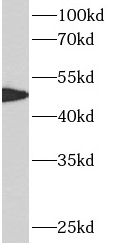Products
ATF4 antibody
| Synonyms: | Cyclic AMP-dependent transcription factor ATF-4 (cAMP-dependent transcription factor ATF-4)|Activating transcription factor 4|Cyclic AMP-responsive element-binding protein 2 (CREB-2 antibody, cAMP-responsive element-binding protein 2)|Tax-responsive enhancer element-binding protein 67 (TaxREB67)|ATF4|CREB2|TXREB antibody | ||
| Catalogue No.: | FNab00663 | Reactivity: | Human, Mouse |
| Host: | Mouse | Tested Application: | ELISA, IHC, WB, IF |
| Clonality: | monoclonal | Isotype: | IgG1 |
| Size | Price |
|---|---|
| 100µg | Inquiry |
- SPECIFICATIONS
- CITATIONS
- FIGURES
- CONDITIONS
- FAQS
- Product Name
- ATF4 antibody
- Catalogue No.
- FNab00663
- Size
- 100μg
- Form
- liquid
- Purification
- Protein A+G purification
- Purity
- ≥95% as determined by SDS-PAGE
- Clonality
- monoclonal
- Isotype
- IgG1
- Clone ID
- 0B11
- Storage
- PBS with 0.02% sodium azide and 50% glycerol pH 7.3, -20℃ for 12 months(Avoid repeated freeze / thaw cycles.)
- Immunogen
- activating transcription factor 4
- Alternative Names
- Cyclic AMP-dependent transcription factor ATF-4 (cAMP-dependent transcription factor ATF-4)|Activating transcription factor 4|Cyclic AMP-responsive element-binding protein 2 (CREB-2 antibody, cAMP-responsive element-binding protein 2)|Tax-responsive enhancer element-binding protein 67 (TaxREB67)|ATF4|CREB2|TXREB antibody
- UniProt ID
- P18848
- Observed MW
- 50-58 kDa
- Tested Applications
- ELISA, IHC, WB, IF
- Recommended dilution
- WB: 1:1000-1:2000; IHC: 1:50-1:300; IF: 1:20-1:100
 HepG2 cells were subjected to SDS PAGE followed by western blot with FNab00663(ATF4 Antibody) at dilution of 1:2000
HepG2 cells were subjected to SDS PAGE followed by western blot with FNab00663(ATF4 Antibody) at dilution of 1:2000
 Immunohistochemistry of paraffin-embedded human breast cancer tissue slide using FNab00663(ATF4 Antibody) at dilution of 1:50 heat mediated antigen retrieved with Tris-EDTA buffer(pH9).
Immunohistochemistry of paraffin-embedded human breast cancer tissue slide using FNab00663(ATF4 Antibody) at dilution of 1:50 heat mediated antigen retrieved with Tris-EDTA buffer(pH9).
- Background
- Transcriptional activator. Binds the cAMP response element(CRE)(consensus: 5'-GTGACGT[AC][AG]-3'), a sequence present in many viral and cellular promoters. Cooperates with FOXO1 in osteoblasts to regulate glucose homeostasis through suppression of beta-cell production and decrease in insulin production(By similarity). It binds to a Tax-responsive enhancer element in the long terminal repeat of HTLV-I. Regulates the induction of DDIT3/CHOP and asparagine synthetase(ASNS) in response to endoplasmic reticulum(ER) stress. In concert with DDIT3/CHOP, activates the transcription of TRIB3 and promotes ER stress-induced neuronal apoptosis by regulating the transcriptional induction of BBC3/PUMA. Activates transcription of SIRT4. Regulates the circadian expression of the core clock component PER2 and the serotonin transporter SLC6A4. Binds in a circadian time-dependent manner to the cAMP response elements(CRE) in the SLC6A4 and PER2 promoters and periodically activates the transcription of these genes. During ER stress response, activates the transcription of NLRP1, possibly in concert with other factors(PubMed:26086088).
- Journal:
- PAIN
- Author:
- Department of Anesthesiology, Sun Yat-sen University Cancer Center, State Key Laboratory of Oncology in South China, Guangdong Provincial Clinical Research Center for Cancer, Guangzhou, China.
- Cited Date:
- 2025-07-18
- Product:
How many times can antibodies be recycled?
First, usually it's not suggested to recycle antibodies. After use, buffer system of antibodies has changed. The storage condition of recycled antibodies for different customers also varies. Thus, the performance efficiency of recycled antibodies can’t be guaranteed. Besides, FineTest ever conducted the antibody recycling assay. Assay results show recycling times of different antibodies also varies. Usually, higher antibody titer allows more repeated use. Customers can determine based on experimental requirements.
Notes: After incubation, we recycle rest antibodies to centrifuge tube and store at 4℃. High titer antibodies can be stored for a minimum of one week. Reuse about three times.
What are components of FineTest antibody buffer?
Components of FineTest antibody buffer are usually PBS with proclin300 or sodium azide, BSA, 50% glycerol. Common preservative is proclin300 or sodium azide, which is widely applied in the lab and industry.
How about the storage temperature and duration of FineTest antibodies?
Most antibodies are stored at -20℃. Directly-labeled flow cytometry antibodies should be stored at 2 - 8℃. The shelf life is one year. If after sales issues for purchased antibodies appear, return or replacement is available. Usually, antibodies can be still used after the one-year warranty. We can offer technical support services.
Is dilution required for FineTest antibodies? What’s the dilute solution?
Directly-labeled flow cytometry antibodies are ready-to-use without dilution. Other antibodies are usually concentrated. Follow the dilution ratio suggested in the manual. Dilute solution for different experiments also varies. Common antibody dilution buffers are acceptable(e.g. PBST, TBST, antibody blocking buffer).
How to retrieve antibodies for immunohistochemistry?
Common retrieval buffers: Tris-EDTA Buffer(pH 9.0); Citrate Buffer(pH 6.0)
Heat induced antibody retrieval:
Method 1: Water-bath heating: Put the beaker with retrieval buffer and slide in the boiling water bath. Keep the boiling state for 15min. Naturally cool to room temperature;
Method 2: Microwave retrieval: Put the beaker with retrieval buffer and slide in the microwave oven. Heat at high power for 5min, Switch OFF for 3min, Heat at medium power for 5min. Naturally cool to room temperature.
How to choose secondary antibodies?
(1) Secondary antibodies react with primary antibodies. Thus, secondary antibodies should be against host species of primary antibodies. E.g. If the primary antibody is derived from rabbit, the relevant secondary antibody should be against rabbit. E.g. goat anti rabbit or donkey anti rabbit.
(2) Choose secondary antibody conjugates according to the experimental type, e.g. ELISA, WB, IHC etc. Common enzyme conjugated secondary antibodies are labelled by HRP, AP etc. Fluorescin or dye labelled secondary antibodies are applied in immunofluorescence and flow cytometry(e.g. FITC, Cy3).
